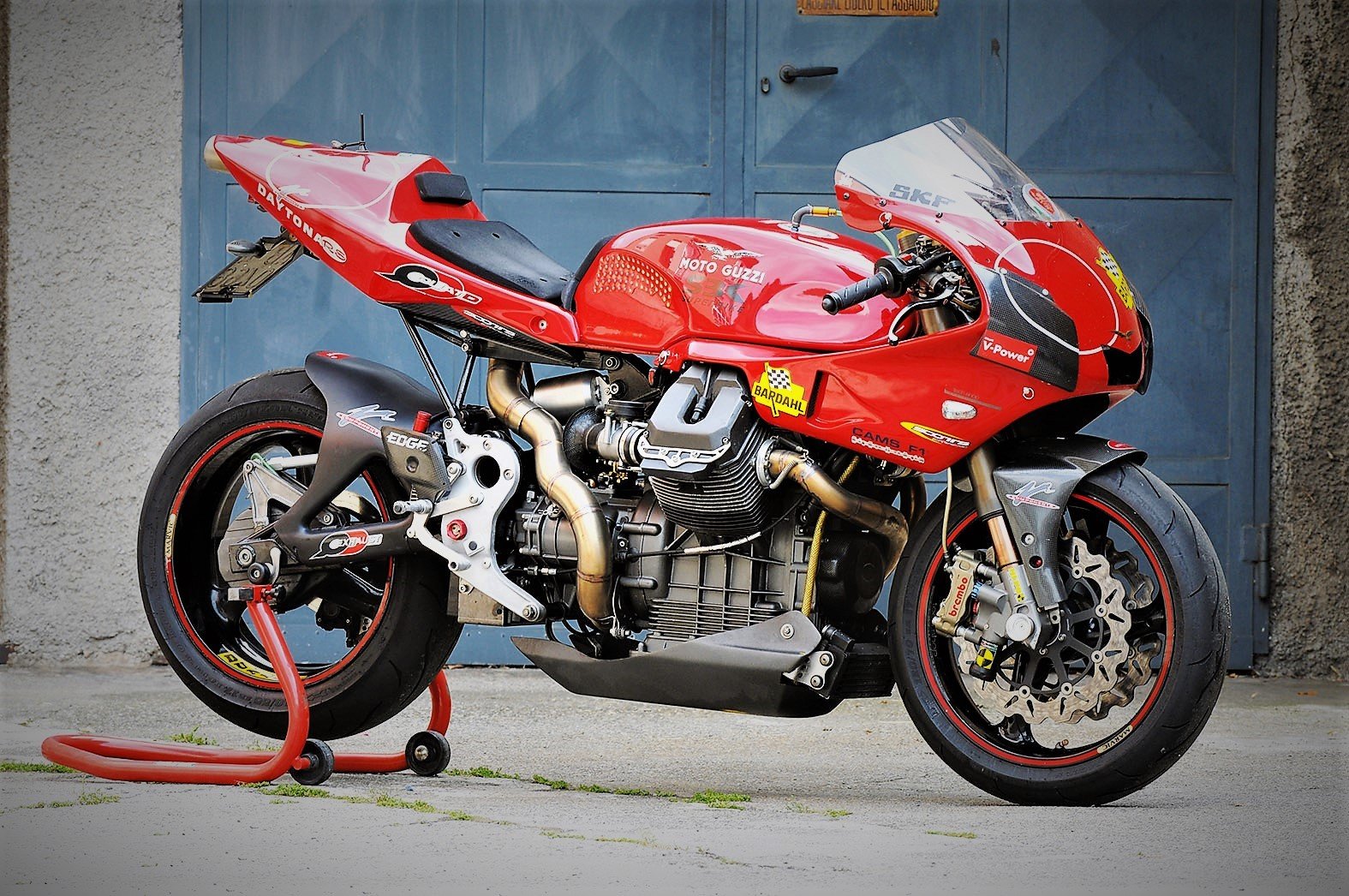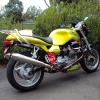-
Posts
5,235 -
Joined
-
Last visited
-
Days Won
268
Content Type
Profiles
Forums
Events
Gallery
Community Map
Everything posted by Lucky Phil
-
Well this might be a complicated discussion. The early 40mm forks from what I have seen of them ( and I haven't had them apart unlike the later forks) control the compression and rebound via fixed orifice ports, correct? The damper piston operates in a sleeve that's bolted to the fork slider at the bottom. Further studying of the manual images it appears the early forks are indeed cartridge types and are able to be disassembled. What I dont know is does the damper rod piston and the "foot valve" ( which could be the compression damping valve but could just be a bottoming out snubber) as described in the manual have genuine shim stacks damping control? As soon as I saw and read from years ago the damping was controlled via fixed orifices and people were modifying them by welding up the holes and re drilling them I labelled them in my head as damper rod forks. This combined with no aftermarket replaceable cartridges for them cemented this impression in my mind. They appear from the images to be a cartridge "style" but is the damping controlled by fixed orifices or shim stacks on piston rod and a compression valve assy?
-
No it is involved. Here is a calculator for example. https://www.rbracing-rsr.com/rakeandtrail.html
-
Damper rod docc. Ciao
-
I'm quite amused by all this forensic interpretation of long or short internal or external fuel tank capacities verses an ITALIAN owners manual specification. That of course together with the almost universal degree of tank swelling these tanks suffer on Ethanol fuels and whatever happens dimensionally to a 20 year old nylon fuel tank as it ages. The only way to really know what the "useable fuel" is for a particular bike is to set the bike on a stand upright and drain the fuel out via the fuel tap until it stops running then close it off and add the measured quantity to bring it up to the full level (whatever that is as everyone has a different assessment of what "full" actually is at the petrol pump) Ciao
-
In the later cartridge style forks docc you can leave the cartridge attached to the lower slider and remove the fork cap, spacer and spring. You don't need a seal remover as you use the upper and lower bush as a driver to remove the seal after you have removed the seal retaining clip. So you use the slider like a slide hammer to drift the seal out and then use a tool to install it. Same pretty much for the early damper rod forks except its the damper rod that stays in the slider and the spring and sleeve and spacer come out. Ciao
-
Ok so I've had to delete my last post on this because it was wrong. I have established without doubt that the later V11 sport triple clamps are indeed "canted" or more correctly have a built in negative rake. You can fairly easily check what your bike has by a measurement insitu. I have a new set of the later black triples and you can confirm by measuring the steering stem hole location in the bottom clamp. If you measure from the edge of the stem hole OD to the front and aft edges of the oval flat face the newer raked clamps measure 11mm and 16mm respectively where the older 0 rake forks measure 13mm and 14mm. So Guzzi have moved the stem forward 2mm in the new lower triple clamps effectively steepening the angle in the lower clamp and left the top clamp the same. So 40mm offset on the top clamp and 38mm for the lower. They have of course machined the fork leg bores at a fractional angle to allow for this so you cant mix and match new and old clamps. Here's an image of a later clamp base and you can see the stem hole is obviously off set on the machined flat face. The earlier lower clamps have the stem hole more centred by 2mm. The effect of this negative offset is to give the bike more trail. How much I don't know but it may also clear up some of the wheel base question marks as well between the bikes which I think have been discussed aside from the long/short frame variations.
-
Ok fine, but to anyone out there contemplating this job using a ring spanner to remove the crank and alternator nuts, good luck with it. Ciao
-
Hows it work with a rattle gun The best and least stressful on the machinery way to remove fasteners like this, the rattle gun. Ciao
-
Yes I got an almost identical one when I bought my bike, Damaged paint to the pork chops and dangerous as hell to use, with the bike moving backwards about 6 inches as it rolls onto the stand. You were also unsighted to one of the nut supports when using it and hoped it hadn't moved out of position as you moved the bike upright and got it settled. It was so dodgy I stopped using it. Anyone that wants it can have it for nothing. The beauty of the socket type with wheels is the stand stays captive on the mount nuts so the stand can't disconnect from the bike and the stand rotates safely and controllable under the bike on its own wheels. It also means you can roll the bike into a front wheel chock so it's vertical and lift the rear of the bike while in the chock. For the sake of $150 or so the other type isn't worth the risk. Ciao
-
Maybe docc but I measured a spare crank and it may be a close thing. From memory I don't think a std deep is long enough. I bought one of these, an extra deep. https://www.australianonlinecarparts.com.au/32mm-x-1-2-dr.-extra-deep.-6pt.impact-skt-127mm-lo It's internal depth is 105mm and overall length 125mm Edit... I dont think thats long enough docc at about 93mm overall length. Ciao
-
"Unless the aircraft is unserviceable and grounded don't start the component removal process until you have the replacement part in your hand" How may times did I need to reinforce this to the aircraft mechanics I supervised. Plus the crank seal. Even if you don't change it it wont cost any extra shipping and if you damage the original during the process you'll have one on hand. Ciao
-
Do tell. Ciao
-
That's a "get you home fix docc". Ciao
-
Tank off, front subframe off, alternator cover and alternator off plus a few other bits and pieces as well as the cover itself. Honestly without the "its a 10 minute job" thing maybe you'd have it off in an hour and a half being careful. My as well change out the crank seal while you have the cover off as well. Ciao
-
Valpolini are from what I've seen a plain metal based gasket with what looks like a pressure sensitive sealant coating. I've used them on rocker covers and they are very good and far superior to the composite gaskets of any kind, silicon or otherwise. The Guzzi timing cover gasket is a similar style but a true "crimped metal" gasket with pressure sensitive sealant so the metal base has been formed to provide some spring to it which means it doesn't rely entirely on the sealant. The "spring" means it adapts to expansion and contraction very well as the engine heat cycles. It's virtually a single layer MLS head gasket in effect. It also provides a more solid layer between the two sealed components so there is not relaxing of the gasket and the securing screws maintain their tension. Cioa
-
The MG cycle gasket is better than the valpolini in my opinion. It's a Guzzi part as well. Ciao
-
Use of course the later coated metal gasket to replace it and cure the issue permanently. Ciao
-
I don't believe any production V11's came out with this gearbox bracket between the frame and the gearbox engine mount studs. It was I believe a "prototype" thing that made it to the parts manual but not "production". Early V11's had the frame mounting brackets but I don't believe any production bikes had it, certainly not the later long frame bikes with the lower fore and aft supports. Ciao
-
The squeaking doesn't bother me Pete but the clunking does Ciao
-
I've never been able to source a comprehensive TDS for any Motul oil hence I won't consider using it. If they won't divulge the details I won't use the product. The worry about conversion to full synthetic oils causing oil leaks is an old debunked story. Ciao
-
The issue is generally with "yellow metal" bearings such as rocker bushes and thrust washers but also to a degree with big end bearings as well I think docc. Any corrosion creates particle which leads to "corrosive wear". It's generally accepted that a flat tappet engines is fine with a minimum of 1000ppm but tests have shown that even 800 ppm is sufficient as a bare minimum. somewhere between 1000-1200 seems the sweet spot. Ciao
-
Corrosion to some bearing and bush material docc. Too much takes the oil in the acidic direction. Ciao
-
Not sure why the Zink level have a "range" of 1600-2000 which is more than is needed anyway. There is a limit to how much Zink is required and anything over about 1400 ppm is of no benefit and can indeed be leaning more towards a negative. A case of more isn't necessarily better. No Full Synthetic motor oil needs or should be built on a 20W base these days. This oil looks like it's aimed at the "old school" people that don't really understand modern oils and always reach for the 20W-50 because they can't change their ways. Like everything else these days there are manufacturers that are quite willing to cater for any market they think they can make a dollar out of whether the product makes any sense or not. We are living in the "too many choices, bespoke world" to an extent now. Best oil grade for a BB Guzzi. Full synthetic 10W-40/50/60 depending on climate and usage with at least 1000ppm Zink. I've run my 2 valve engine on Mobil1 0W-40 for years and the Daytona engine on Full Synth 10W-60 Penrite as it has some special needs. Ciao





